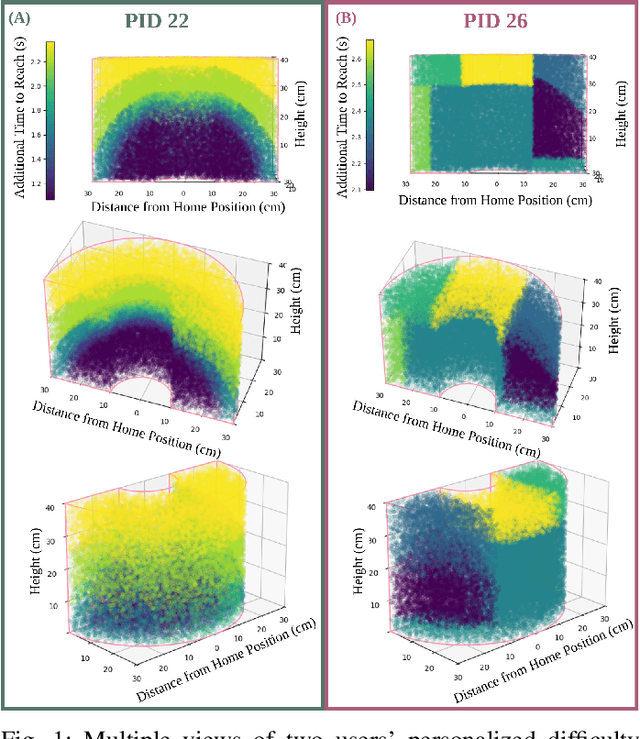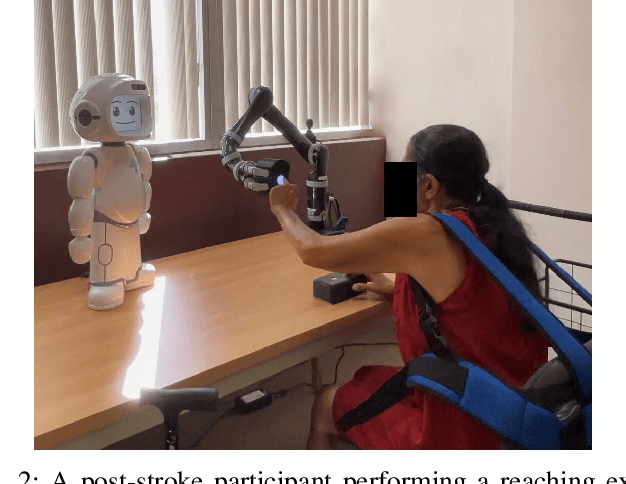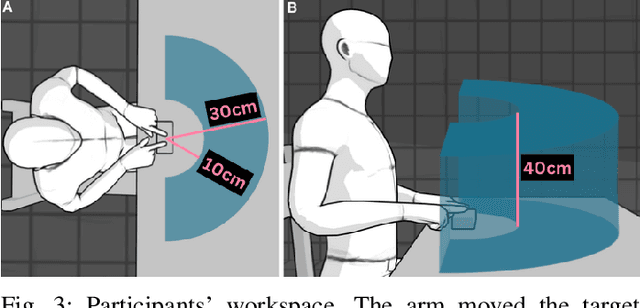Nathaniel Dennler
The Current State of AI Bias Bounties: An Overview of Existing Programmes and Research
Oct 02, 2025Abstract:Current bias evaluation methods rarely engage with communities impacted by AI systems. Inspired by bug bounties, bias bounties have been proposed as a reward-based method that involves communities in AI bias detection by asking users of AI systems to report biases they encounter when interacting with such systems. In the absence of a state-of-the-art review, this survey aimed to identify and analyse existing AI bias bounty programmes and to present academic literature on bias bounties. Google, Google Scholar, PhilPapers, and IEEE Xplore were searched, and five bias bounty programmes, as well as five research publications, were identified. All bias bounties were organised by U.S.-based organisations as time-limited contests, with public participation in four programmes and prize pools ranging from 7,000 to 24,000 USD. The five research publications included a report on the application of bug bounties to algorithmic harms, an article addressing Twitter's bias bounty, a proposal for bias bounties as an institutional mechanism to increase AI scrutiny, a workshop discussing bias bounties from queer perspectives, and an algorithmic framework for bias bounties. We argue that reducing the technical requirements to enter bounty programmes is important to include those without coding experience. Given the limited adoption of bias bounties, future efforts should explore the transferability of the best practices from bug bounties and examine how such programmes can be designed to be sensitive to underrepresented groups while lowering adoption barriers for organisations.
HRIBench: Benchmarking Vision-Language Models for Real-Time Human Perception in Human-Robot Interaction
Jun 25, 2025Abstract:Real-time human perception is crucial for effective human-robot interaction (HRI). Large vision-language models (VLMs) offer promising generalizable perceptual capabilities but often suffer from high latency, which negatively impacts user experience and limits VLM applicability in real-world scenarios. To systematically study VLM capabilities in human perception for HRI and performance-latency trade-offs, we introduce HRIBench, a visual question-answering (VQA) benchmark designed to evaluate VLMs across a diverse set of human perceptual tasks critical for HRI. HRIBench covers five key domains: (1) non-verbal cue understanding, (2) verbal instruction understanding, (3) human-robot object relationship understanding, (4) social navigation, and (5) person identification. To construct HRIBench, we collected data from real-world HRI environments to curate questions for non-verbal cue understanding, and leveraged publicly available datasets for the remaining four domains. We curated 200 VQA questions for each domain, resulting in a total of 1000 questions for HRIBench. We then conducted a comprehensive evaluation of both state-of-the-art closed-source and open-source VLMs (N=11) on HRIBench. Our results show that, despite their generalizability, current VLMs still struggle with core perceptual capabilities essential for HRI. Moreover, none of the models within our experiments demonstrated a satisfactory performance-latency trade-off suitable for real-time deployment, underscoring the need for future research on developing smaller, low-latency VLMs with improved human perception capabilities. HRIBench and our results can be found in this Github repository: https://github.com/interaction-lab/HRIBench.
Modeling Personalized Difficulty of Rehabilitation Exercises Using Causal Trees
May 07, 2025



Abstract:Rehabilitation robots are often used in game-like interactions for rehabilitation to increase a person's motivation to complete rehabilitation exercises. By adjusting exercise difficulty for a specific user throughout the exercise interaction, robots can maximize both the user's rehabilitation outcomes and the their motivation throughout the exercise. Previous approaches have assumed exercises have generic difficulty values that apply to all users equally, however, we identified that stroke survivors have varied and unique perceptions of exercise difficulty. For example, some stroke survivors found reaching vertically more difficult than reaching farther but lower while others found reaching farther more challenging than reaching vertically. In this paper, we formulate a causal tree-based method to calculate exercise difficulty based on the user's performance. We find that this approach accurately models exercise difficulty and provides a readily interpretable model of why that exercise is difficult for both users and caretakers.
Soft and Compliant Contact-Rich Hair Manipulation and Care
Jan 05, 2025



Abstract:Hair care robots can help address labor shortages in elderly care while enabling those with limited mobility to maintain their hair-related identity. We present MOE-Hair, a soft robot system that performs three hair-care tasks: head patting, finger combing, and hair grasping. The system features a tendon-driven soft robot end-effector (MOE) with a wrist-mounted RGBD camera, leveraging both mechanical compliance for safety and visual force sensing through deformation. In testing with a force-sensorized mannequin head, MOE achieved comparable hair-grasping effectiveness while applying significantly less force than rigid grippers. Our novel force estimation method combines visual deformation data and tendon tensions from actuators to infer applied forces, reducing sensing errors by up to 60.1% and 20.3% compared to actuator current load-only and depth image-only baselines, respectively. A user study with 12 participants demonstrated statistically significant preferences for MOE-Hair over a baseline system in terms of comfort, effectiveness, and appropriate force application. These results demonstrate the unique advantages of soft robots in contact-rich hair-care tasks, while highlighting the importance of precise force control despite the inherent compliance of the system.
Contrastive Learning from Exploratory Actions: Leveraging Natural Interactions for Preference Elicitation
Jan 02, 2025



Abstract:People have a variety of preferences for how robots behave. To understand and reason about these preferences, robots aim to learn a reward function that describes how aligned robot behaviors are with a user's preferences. Good representations of a robot's behavior can significantly reduce the time and effort required for a user to teach the robot their preferences. Specifying these representations -- what "features" of the robot's behavior matter to users -- remains a difficult problem; Features learned from raw data lack semantic meaning and features learned from user data require users to engage in tedious labeling processes. Our key insight is that users tasked with customizing a robot are intrinsically motivated to produce labels through exploratory search; they explore behaviors that they find interesting and ignore behaviors that are irrelevant. To harness this novel data source of exploratory actions, we propose contrastive learning from exploratory actions (CLEA) to learn trajectory features that are aligned with features that users care about. We learned CLEA features from exploratory actions users performed in an open-ended signal design activity (N=25) with a Kuri robot, and evaluated CLEA features through a second user study with a different set of users (N=42). CLEA features outperformed self-supervised features when eliciting user preferences over four metrics: completeness, simplicity, minimality, and explainability.
Improving User Experience in Preference-Based Optimization of Reward Functions for Assistive Robots
Nov 17, 2024



Abstract:Assistive robots interact with humans and must adapt to different users' preferences to be effective. An easy and effective technique to learn non-expert users' preferences is through rankings of robot behaviors, for example, robot movement trajectories or gestures. Existing techniques focus on generating trajectories for users to rank that maximize the outcome of the preference learning process. However, the generated trajectories do not appear to reflect the user's preference over repeated interactions. In this work, we design an algorithm to generate trajectories for users to rank that we call Covariance Matrix Adaptation Evolution Strategies with Information Gain (CMA-ES-IG). CMA-ES-IG prioritizes the user's experience of the preference learning process. We show that users find our algorithm more intuitive and easier to use than previous approaches across both physical and social robot tasks. This project's code is hosted at github.com/interaction-lab/CMA-ES-IG
Inclusion in Assistive Haircare Robotics: Practical and Ethical Considerations in Hair Manipulation
Nov 07, 2024
Abstract:Robot haircare systems could provide a controlled and personalized environment that is respectful of an individual's sensitivities and may offer a comfortable experience. We argue that because of hair and hairstyles' often unique importance in defining and expressing an individual's identity, we should approach the development of assistive robot haircare systems carefully while considering various practical and ethical concerns and risks. In this work, we specifically list and discuss the consideration of hair type, expression of the individual's preferred identity, cost accessibility of the system, culturally-aware robot strategies, and the associated societal risks. Finally, we discuss the planned studies that will allow us to better understand and address the concerns and considerations we outlined in this work through interactions with both haircare experts and end-users. Through these practical and ethical considerations, this work seeks to systematically organize and provide guidance for the development of inclusive and ethical robot haircare systems.
Using Causal Trees to Estimate Personalized Task Difficulty in Post-Stroke Individuals
Mar 06, 2024

Abstract:Adaptive training programs are crucial for recovery post stroke. However, developing programs that automatically adapt depends on quantifying how difficult a task is for a specific individual at a particular stage of their recovery. In this work, we propose a method that automatically generates regions of different task difficulty levels based on an individual's performance. We show that this technique explains the variance in user performance for a reaching task better than previous approaches to estimating task difficulty.
Singing the Body Electric: The Impact of Robot Embodiment on User Expectations
Jan 13, 2024

Abstract:Users develop mental models of robots to conceptualize what kind of interactions they can have with those robots. The conceptualizations are often formed before interactions with the robot and are based only on observing the robot's physical design. As a result, understanding conceptualizations formed from physical design is necessary to understand how users intend to interact with the robot. We propose to use multimodal features of robot embodiments to predict what kinds of expectations users will have about a given robot's social and physical capabilities. We show that using such features provides information about general mental models of the robots that generalize across socially interactive robots. We describe how these models can be incorporated into interaction design and physical design for researchers working with socially interactive robots.
A metric for characterizing the arm nonuse workspace in poststroke individuals using a robot arm
Jan 13, 2024Abstract:An over-reliance on the less-affected limb for functional tasks at the expense of the paretic limb and in spite of recovered capacity is an often-observed phenomenon in survivors of hemispheric stroke. The difference between capacity for use and actual spontaneous use is referred to as arm nonuse. Obtaining an ecologically valid evaluation of arm nonuse is challenging because it requires the observation of spontaneous arm choice for different tasks, which can easily be influenced by instructions, presumed expectations, and awareness that one is being tested. To better quantify arm nonuse, we developed the Bimanual Arm Reaching Test with a Robot (BARTR) for quantitatively assessing arm nonuse in chronic stroke survivors. The BARTR is an instrument that utilizes a robot arm as a means of remote and unbiased data collection of nuanced spatial data for clinical evaluations of arm nonuse. This approach shows promise for determining the efficacy of interventions designed to reduce paretic arm nonuse and enhance functional recovery after stroke. We show that the BARTR satisfies the criteria of an appropriate metric for neurorehabilitative contexts: it is valid, reliable, and simple to use.
* Accepted to Science Robotics at https://www.science.org/doi/10.1126/scirobotics.adf7723 on November 15th, 2023
 Add to Chrome
Add to Chrome Add to Firefox
Add to Firefox Add to Edge
Add to Edge